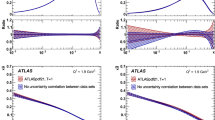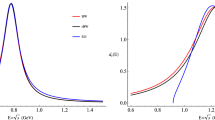Summary
The simplest vertex-type diagrams for K → 3π decay contain an internal double pion line: when the total rest-mass parameter λ of this line is taken as discrete, the amplitude possesses on the physical sheet an anomalous branch point above the normal one, subject to the condition (M2 − μ2) /2 < λ2 − (M μ)2 withM the kaon andμ the pion mass. On integrating over λ2 this singularity is eliminated. In order to understand the amplitude fully, we must consider it temporarily as a function of two complex variables, in which a double dispersion representation is found to hold. The spectral functions are examined in semiclosed form to exemplify these statements, and to give a perturbationtheory illustration of some of the popular approximations in calculations on this decay.
Riassunto
I più semplici diagrammi del tipo a vertice per il decadimento K → 3π contengono una linea interna per il doppio pione: se si prende come quantità discreta il parametroλ della massa totale di riposo di quest a linea, l’ampiezza possiede sul foglietto fisico, al di sopra di quello normale, un pun to anomalo di branching, sottoposto alla condizione (M2 - μ2)/2 < λ2 < (M -μ)2, in cuiM è la massa del kaone eμ quella del pione. Per integrazione in λ2 si elimina questa singolarità. Per comprendere appieno l’ampiezza, dobbiamo considerarla temporaneamente come funzione di due variabili complesse, in cui si tvova che è valida una rappresentazione con doppia dispersione. Per fare un esempio di queste affermazioni e per dare una illustrazione in Teoria della perturbazione di alcune delle approssimazioni più comuni nei calcoli di quesro decadimento, si esaminano le funzioni spettrali in forma semichiusa.
Similar content being viewed by others
References
N. N. Khuri andS. B. Treiman:Phys. Rev.,119, 1115 (1960).
R. F. Sawyer andK. C. Wali:Phys. Rev.,119, 1429 (1960).
S. Fubini andE. Stroffolini:Nuovo Cimento,17, 263 (1960).
Cf. also the Proceedings of the 1960 Rochester Conference.
A similar idea has been exploited in a different context byY. Fujii andS. Furuichi:Prog. Theor. Phys.,23, 251 (1960).
J. M. Jauch andF. Rohrlich:The Theory of Photons and Electrons (Cambridge, Mass., 1955).
J. T. Tarski:Journ. Math. Phys.,1, 149 (1960).
M. Fowler, P. V. Landshoff andR. W. Lardner:Nuovo Cimento,17, 956 (1960).
P. V. Landshoff andS. B. Treiman : Cambridge preprint (1960).
G. Bonnevay:Proceedings of the 1960 Rochester Conference, p. 523; but cf. also the report on the subsequent discussion.
R. Blankenbecler andY. Nambu:Nuovo Cimento,18, 595 (1960).
Author information
Authors and Affiliations
Additional information
On leave of absence from Christ Church, Oxford. Supported by a grant to the Institute from the Xational Science Foundation.
On leave of absence from Magdalen College, Oxford. Supported in part by the U.S.A.F. Office of Scientific Research. Air Research and Development Command.
Rights and permissions
About this article
Cite this article
Barton, G., Kacser, C. Some analytic properties of a decay amplitude with final state interactions. Nuovo Cim 21, 593–604 (1961). https://doi.org/10.1007/BF02828796
Received:
Published:
Issue Date:
DOI: https://doi.org/10.1007/BF02828796




